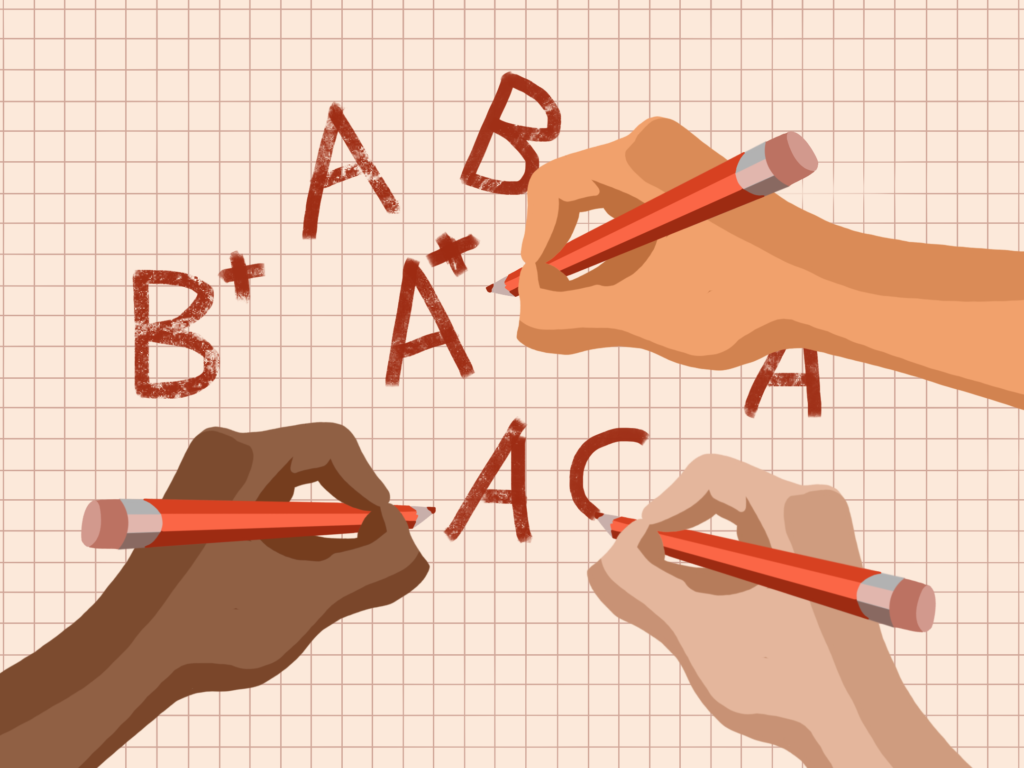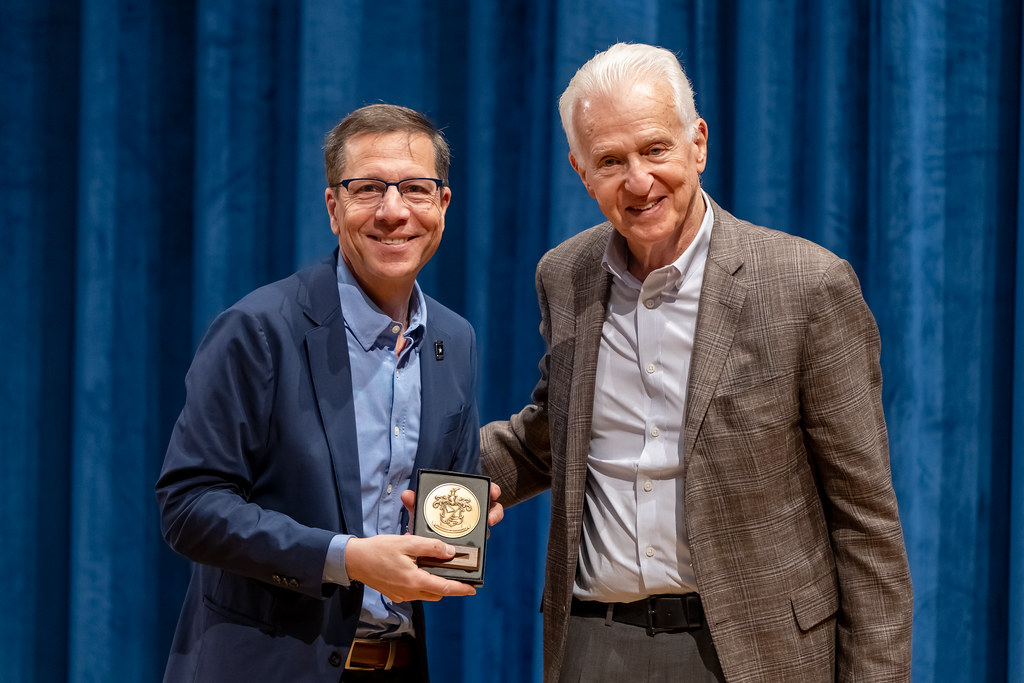
At Choate, teachers are required to give their students a grade “on an A through F rating with (+) and (-) indicators,” as written in the 2021-2022 Student Handbook. Students’ cumulative grades in each class are shown to them and their advisers twice in each of the three terms in the year: once at the midterm and once at the conclusion of the term. So, every few months, students eagerly check ChoateSIS, the School’s portal, to see if their grades have been released.
Traditionally, homework, essays, quizzes, projects, and tests are graded throughout the term. Most teachers also take into account completion of homework rather than accuracy, class participation, and other factors. Despite some similarities in grading methods, grading remains subjective across students and faculty, raising questions of what grades truly mean to the Choate community.
The Choate News recently surveyed students on their views on, and experiences with, grading at Choate. Of the 108 respondents, only 11% agreed that Choate has a standardized grading system —that is, one in which where every teacher grades to a single objective rubric — while 87% either disagreed or strongly disagreed.
“Sometimes grades on individual assignments feel next to arbitrary,” said Chloe Jacobs ’23. “Half the work of getting the best grade you can in a class requires learning a teacher’s preferences and grading style.”
One student who responded to the survey said “Some teachers believe that an A is the baseline grade for a student, with higher or lower grades being offered for particularly exemplary or poor work. Other teachers set that baseline at a B+ or even lower, and push students to exceed expectations in order to earn an A.“
In an attempt to uphold a standardized grading system at Choate, Director of Studies and chemistry teacher Mr. Kevin Rogers evaluates whether the grading methods across different sections of a course are “substantially similar.” To do so, he considers what is being asked of students in a course, the time that they are investing in the subject, and how different aspects of the course are weighted in the final grade. Still, he noted that grading “of course, lends itself to subjectivity in it, so we don’t require that all sections of the multi-section course be identical.”
Other teachers agree that there will likely never be a completely standardized grading system. “I think we’re all human. We all see and value things differently — and I’m speaking purely for English,” said English teacher Mr. Derek Palmore.
For Mr. Palmore, grades are a straightforward way for students to gauge their performance in class. “One of my goals with grades is, in some sense, to give students a sense of what their strengths are, what they need to work on,” he said. “I see grades as a way for students to understand their level of success in a class.”
However, when pressures to attain certain grades stem from extrinsic factors, such as peer pressure, parental expectations, and looming college applications, grades can become a major source of anxiety and stress for students. On a scale of 1-5, where 5 represented that a student’s grade meant a lot to them and 1 represented indifference, 47% of surveyed students answered with a 5, and another 45% answered with a 4.
“I’ve dealt with many crying students because of grades,” said physics teacher and Associate Dean of Equity and Inclusion Mr. Filipe Camarotti. “There’s an emotional response to grades, which I think means that grades mean something’s at stake.” 65% of the survey respondents strongly agreed, and another 27%, agreed, that they would be upset with what they believed to be a “bad” grade.
Students and teachers define a “bad” grade differently. In the survey, 25% of students responded that they would consider B- as an unacceptable letter grade, while another 24% reposnded with a B and B+ respectively. 7% responded with an A-, and 11% responded with a C+.
Many students noted that they often equate their grades with their self-worth and use them as a form of self-validation. “I do my best to separate my worth from my grades, but when family, peers, and even strangers compliment me for my academic achievements and good grades, that positive reinforcement inevitably affects my self-worth,” said Jacobs.
While Mr. Rogers believes that grades serve as a shorthand indication of how a student is doing in a class, he considers narrative feedback and the student’s digestion of that feedback to be more important. “I would love to give narrative feedback and not have to translate that narrative feedback into a representative grade,” he said.
Mr. Morgan Harris, Director of Academic Technology and HPRSS teacher, describes himself as being in “a very experimental phase with figuring out how to best approach grading.”
Instead of being graded on assignments throughout the term, students in Mr. Harris’s classes write two reflections, one at midterm and one at the end of the term. Students will “compose a comprehensive reflection on what they’ve done in the course and how they’ve grown as a person … to take an honest look at their relationship with the course and then advocate for what grade they believe they deserve,” he said.
Mr. Harris has questioned why most institutions, including Choate, give grades. He said, “The answer seems to always come back to ‘because if we didn’t, it could disadvantage our kids in the college application process.’” However, he is curious if “the other various benefits of not having grades would ultimately make that student a more compelling candidate, because they are able to tap into their intrinsic motivation, explore their passions, and be such an authentic applicant.”
Researching the origin, relevance, and effectiveness of grades, Mr. Harris found that grades originated in the Western Enlightenment, a time of revolutionary inventions resulting from newfound abilities to measure, analyze, and quantify. The first grades can be traced back to a footnote in former Yale President Ezra Stiles’s journal, which sorted students into Optimi, Second Optimi, Inferiores, and Pejores — from there, students began to be analyzed and quantified through grades.
“What we’re doing is we’re setting up all of these incentive structures to measure everything possible,” Mr. Harris said. “It can create perverse incentives for people to become addicted to the affirmation that some quantifiable measure gives to them. And in succumbing to that addiction, you lose sight of why you’re here in the first place.”
Lilli Schmidt-Engelbertz ’23, who is currently taking Mr. Harris’s Moral Reasoning class, said, “You do the homework not to get the grade on it, but you do the homework because you actually want to learn it.” Her mindset has shifted from having to produce a paper to simply creating a reflection, which has allowed her to be more thoughtful, straightforward, and authentic in her responses to class materials.
During the pandemic, many students were forced to reevaluate their styles of learning and teaching under times of uncertainty and remote learning. Students were taking classes in different environments with different resources available to them, while teachers adapted to both their students’ new lifestyles and their new classrooms — Zoom.
Mr. Camarotti believes that the pandemic has exposed the flaws and inequities of the grading and education system at large. “And so, a way to respond to inequity is to then take a closer look at the system — grading as a system,” he said. For example, a student living in a different time zone and with different access to technology and space can unfairly affect their experience in a class. Speaking on how he adjusted to teaching in a pandemic, especially during virtual learning, Mr. Camarotti said, “I can’t just give a quiz in the same way. So let’s think more creatively — let’s expand how to assign something.”
Currently, the School offers the option for students to take classes on a Pass/D/Fail basis with the approval of Mr. Rogers and in consultation with the student’s dean, department head, adviser, and college counselor. Yet, many students are hesitant to switch to the Pass/D/Fail option in fear of hurting their chances in college admissions.
“I wish I could’ve taken Pass/D/Fail in some of my classes that made me overly stressed so that I could enjoy learning the content more,” said Ellie Pyper ’22. “If there wasn’t the stigma that Pass/D/Fail would look bad on my transcript for college applications, I definitely would try more classes.”
Mr. Rogers noted that grades are an important metric used by external institutions, such as colleges, scholarship programs, and internships — opportunities often sought by Choate students. “For better or for worse, the A-B-C-D-F system that we use is widely translatable and understood across a wide spectrum of outside constituencies that would be interested in seeing what students are doing in high school academically,” he said.
Grades continue to be a crucial element in the classrooms at Choate and in the American education system as a whole. As teachers adjust and adapt to changing times, the way that they evaluate students’ work will change too.




